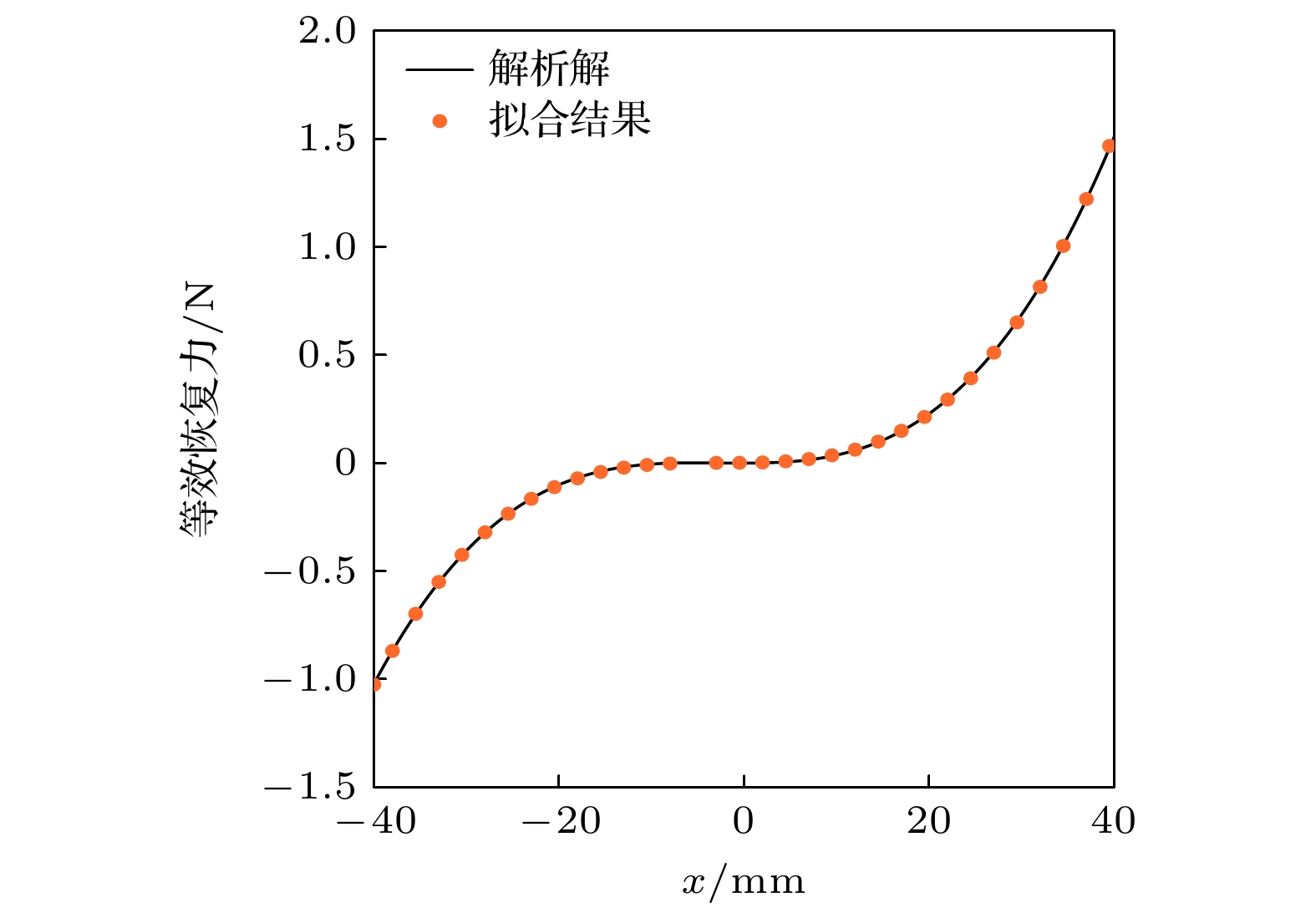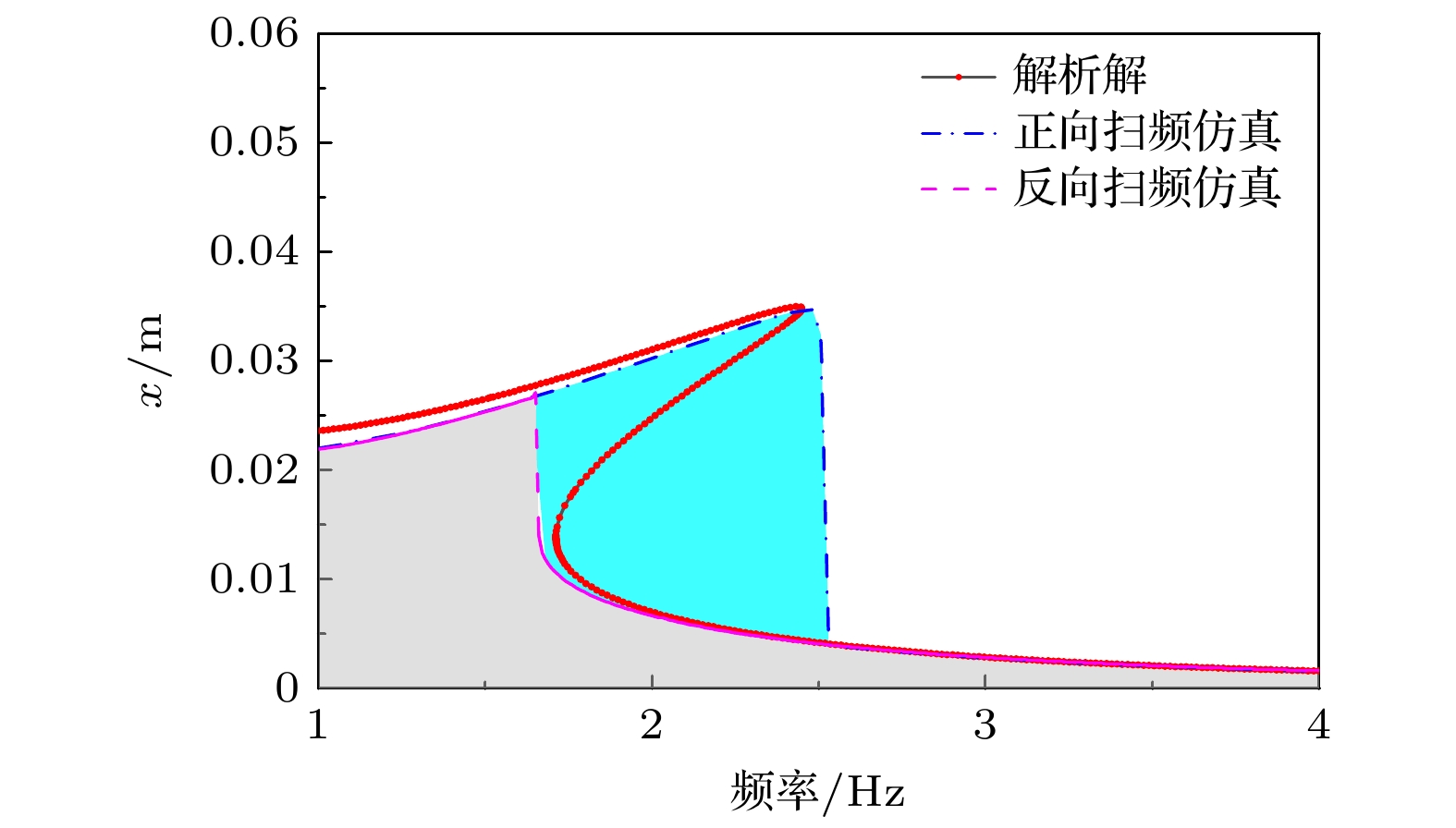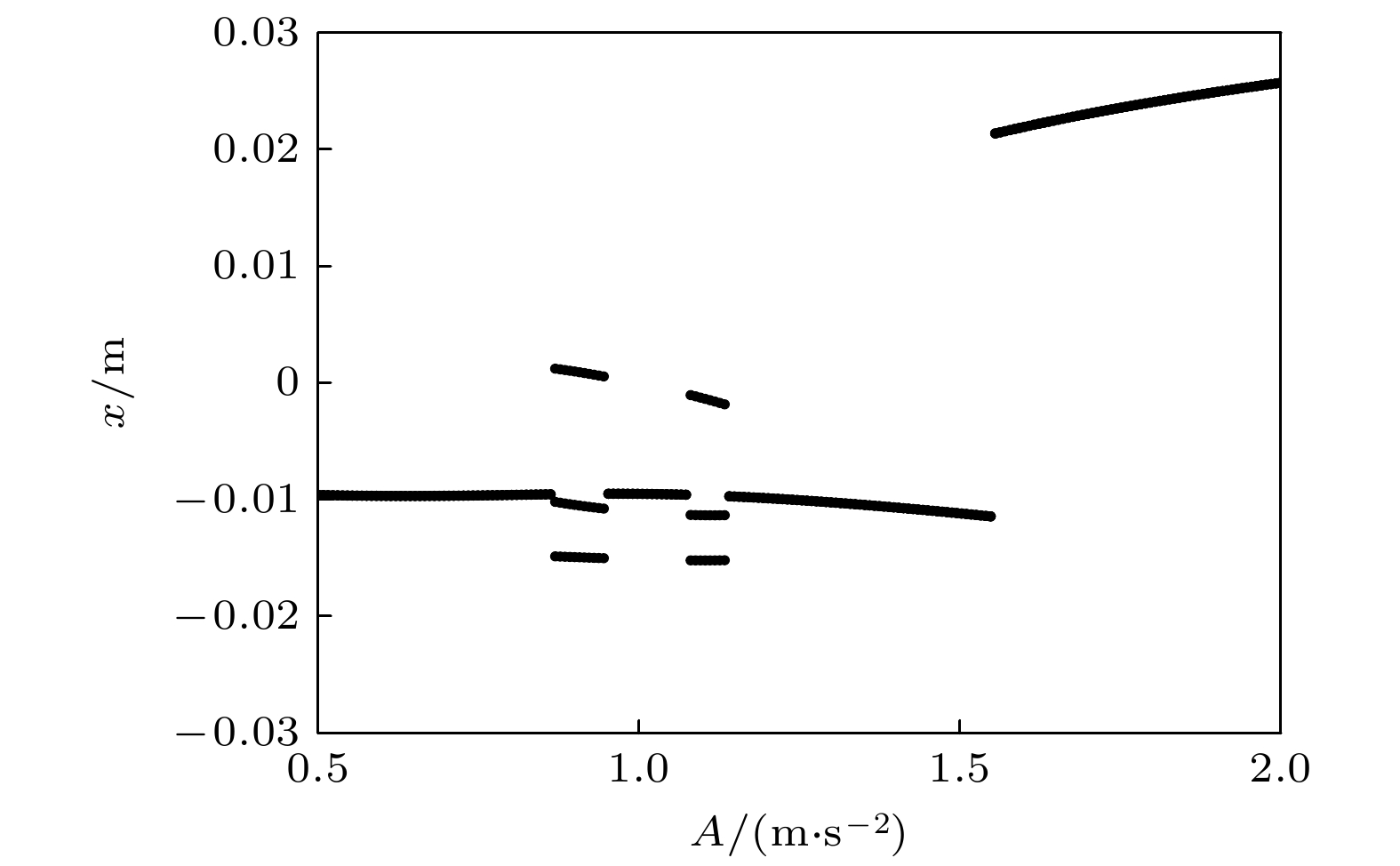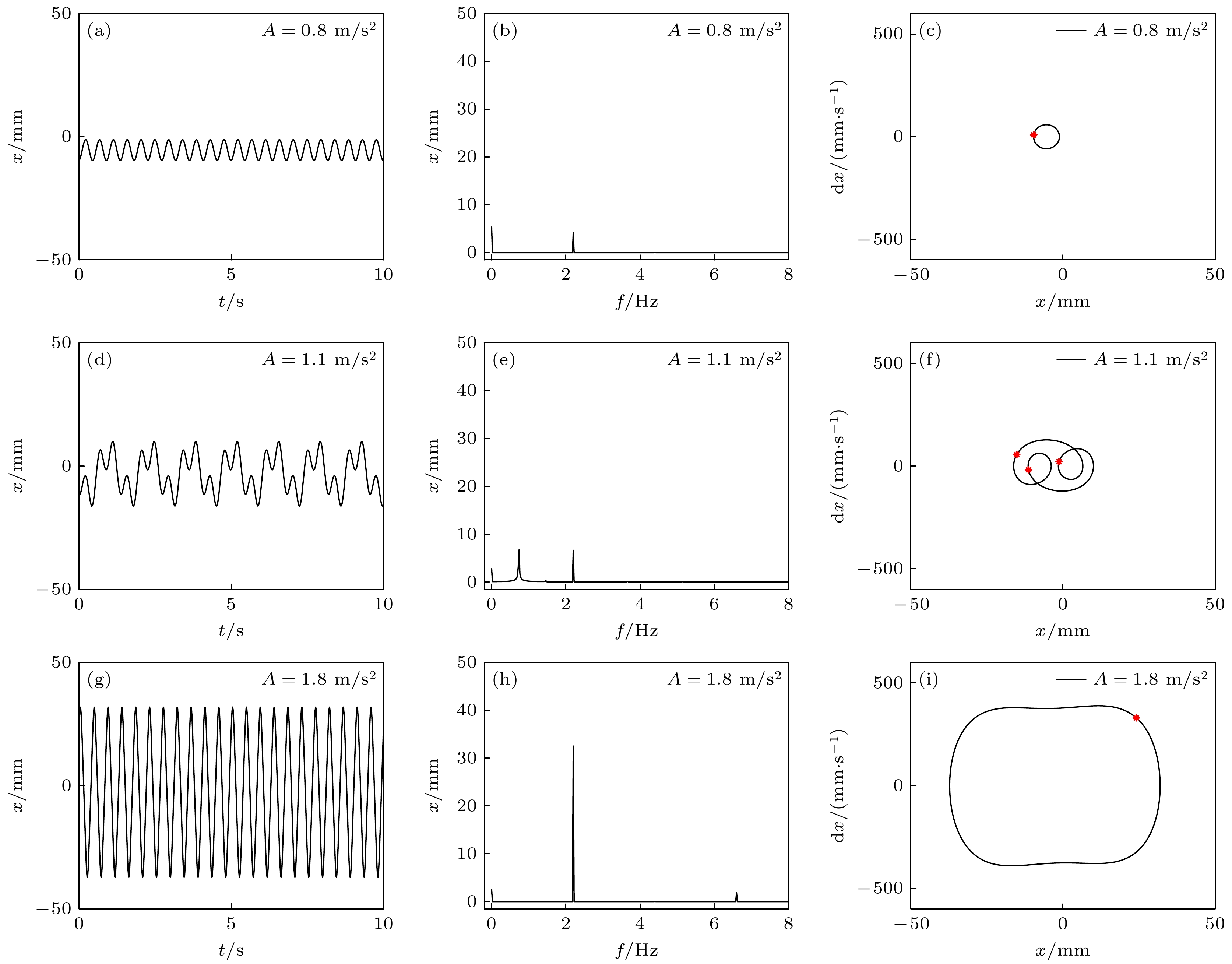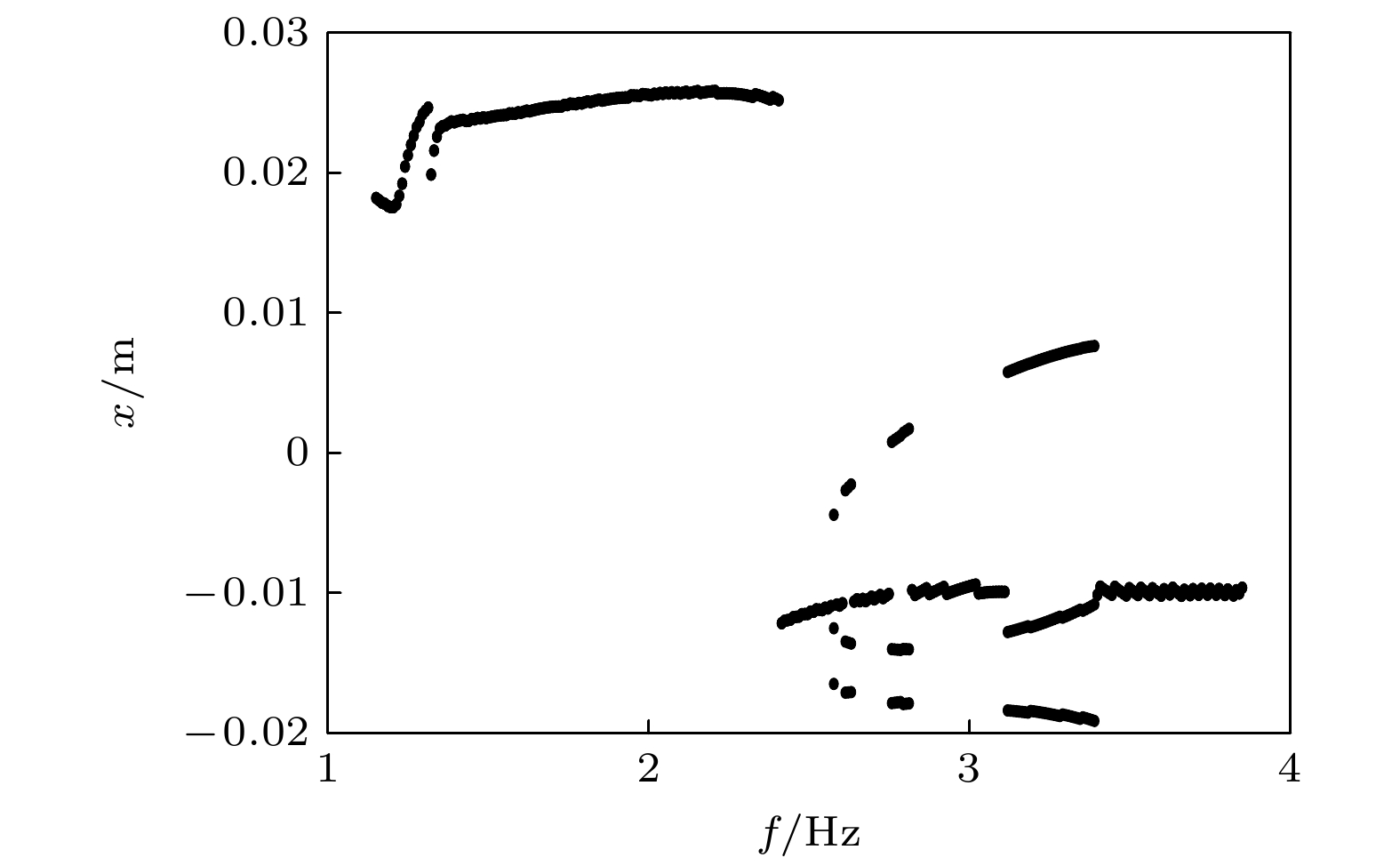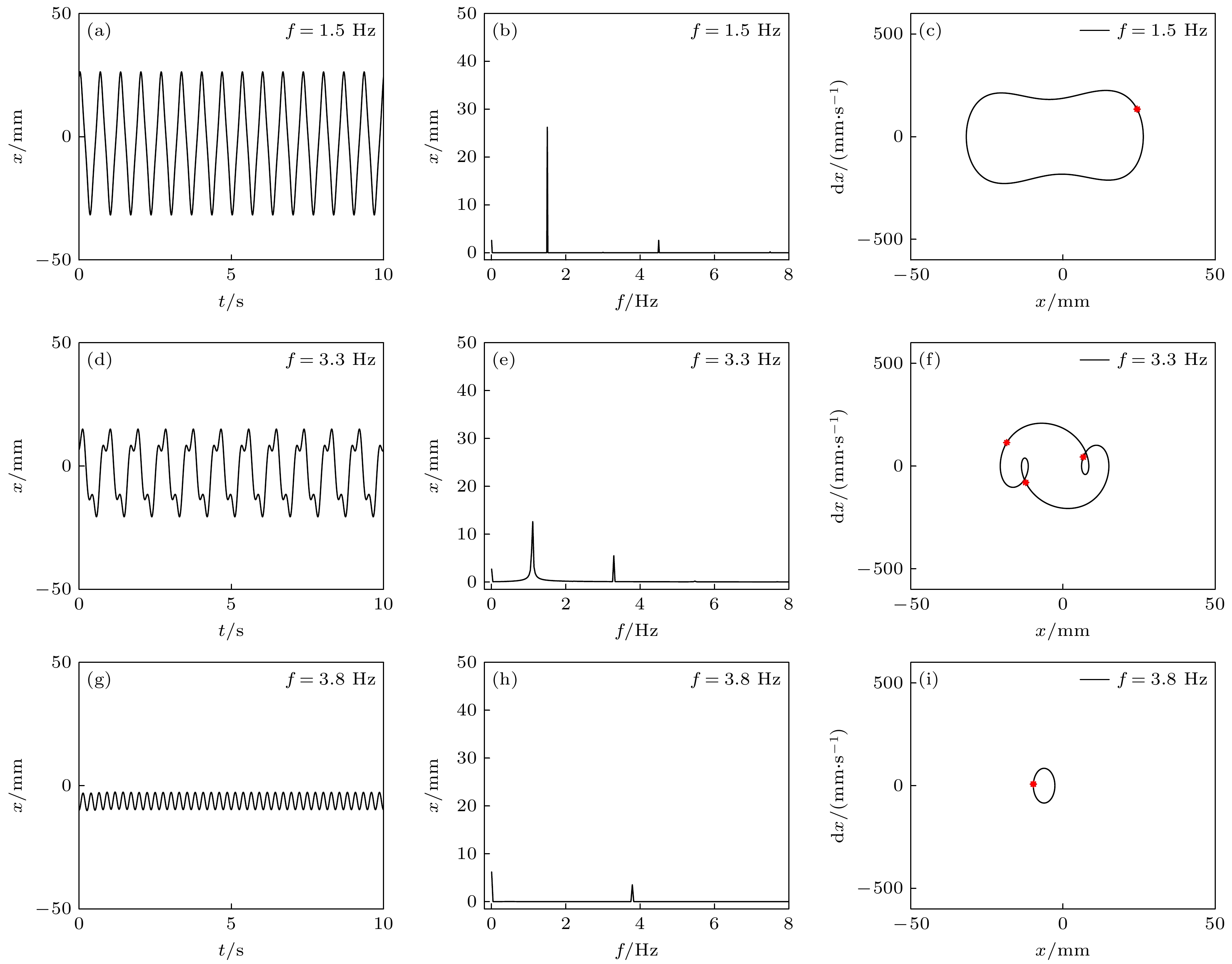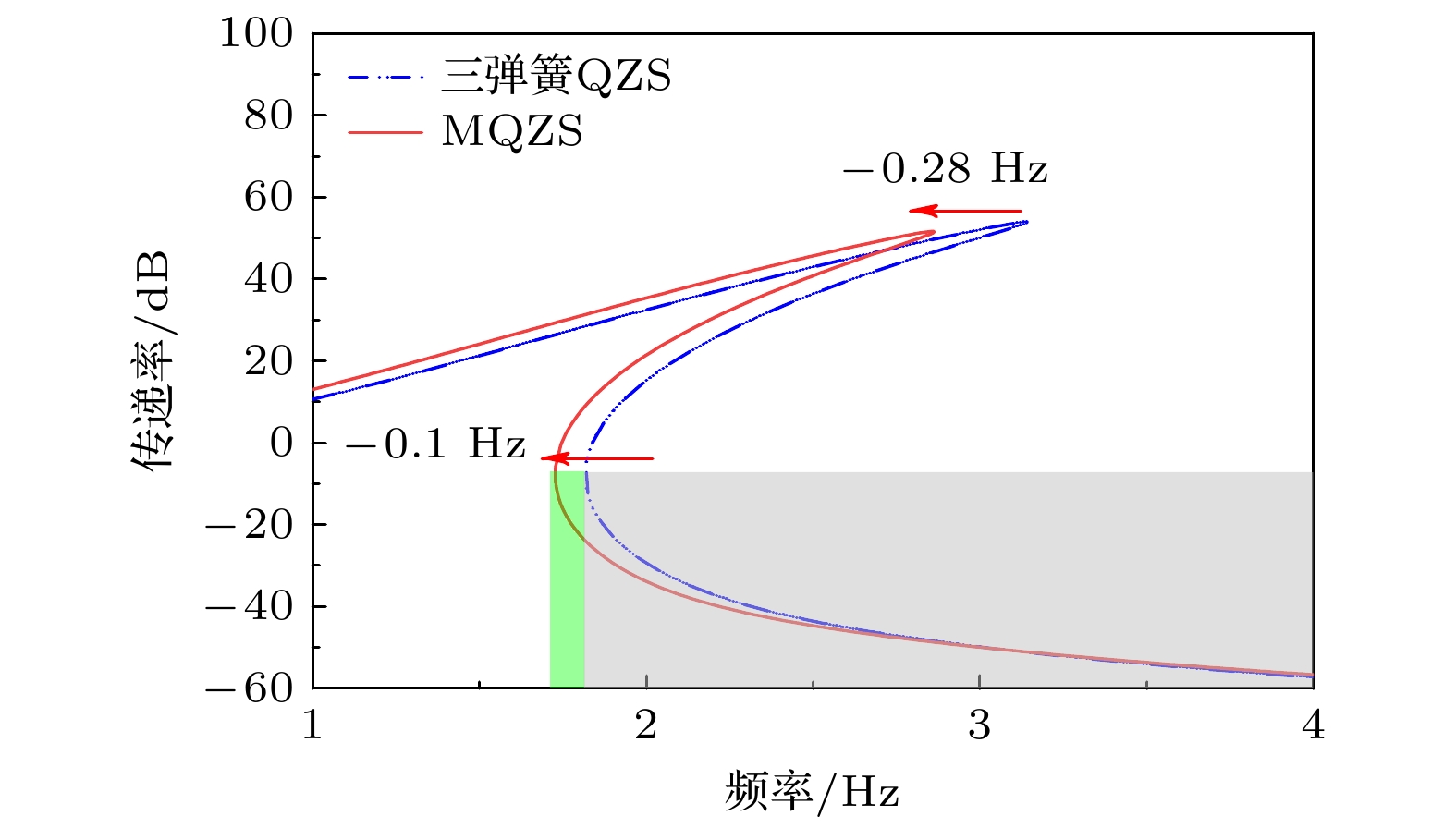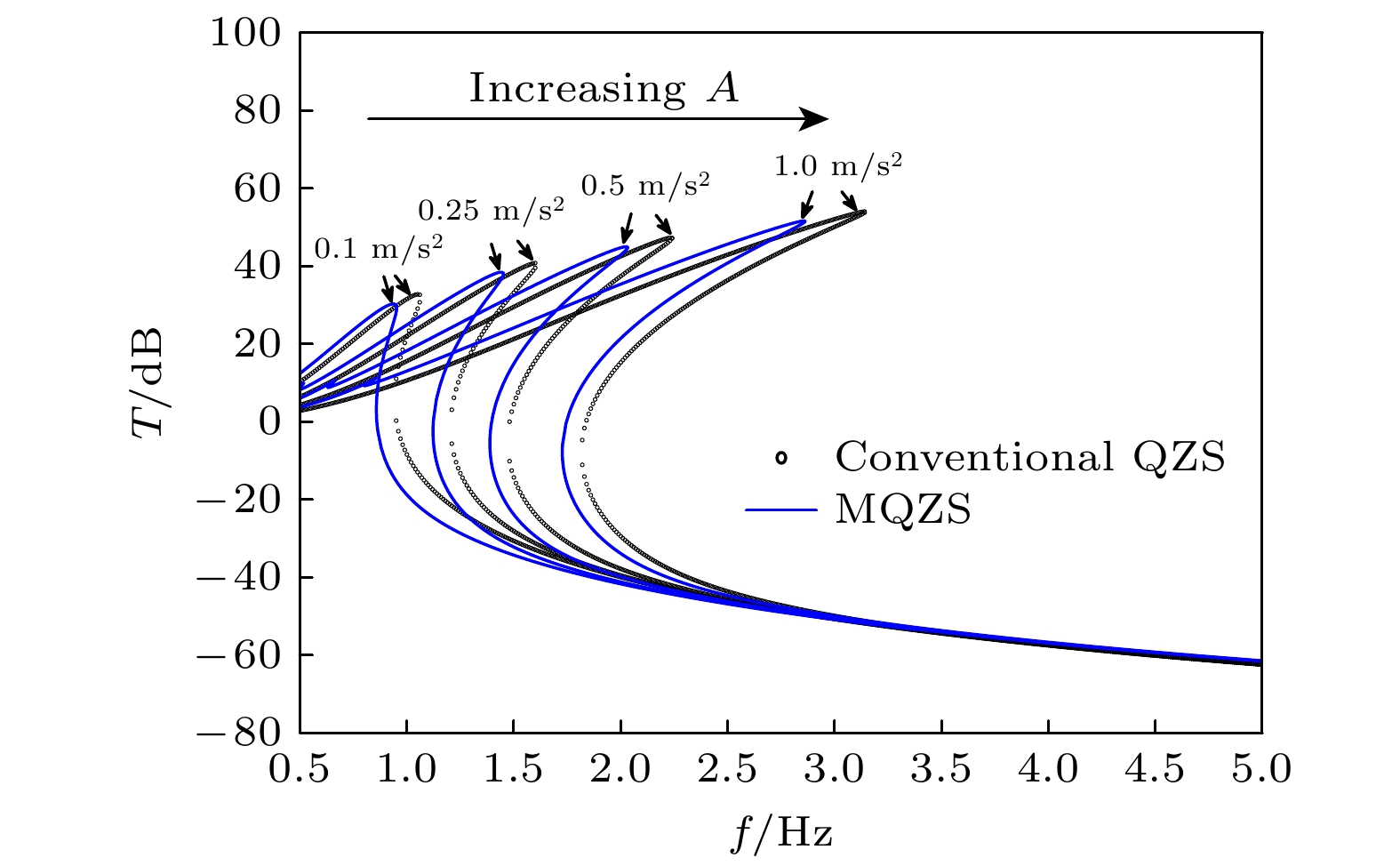-
Arthropods, including spiders and mantises, can maintain their body stability on shaking surfaces, such as spiderwebs or leaves. This impressive stability can be attributed to the specific geometric shape of their limbs, which exhibit an M-shaped structure. Inspired by this geometry, this work proposes an arthropod-limb-inspired M-shaped structure for low-frequency vibration isolation. First, the design method of the M-shaped quasi-zero-stiffness (QZS) structure is presented. A static analysis of potential energy, restoring force, and equivalent stiffness is conducted, showing that the M-shaped structure enables a horizontal linear spring to generate nonlinear stiffness in the vertical direction. More importantly, this nonlinear stiffness effectively compensates for the negative stiffness in large-displacement responses, thereby achieving a wider quasi-zero-stiffness region than the conventional three-spring-based QZS structure. Subsequently, the harmonic balance method is employed to derive approximate analytical solutions for the M-shaped QZS structure, which are well validated through numerical simulation. A comparison between the proposed M-shaped QZS structure and the conventional three-spring-based QZS structure is performed. Results show that the M-shaped QZS structure is advantageous for reducing both the cut-in isolation frequency and the resonance frequency. In particular, under large excitation or small damping conditions, the performance improvement of the M-shaped QZS structure in terms of reducing the resonance frequency and maximum response becomes more pronounced. The underlying mechanism behind this feature is primarily attributed to the expanded QZS region induced by the M-shaped structure. Finally, since the M-shaped structures vary among different arthropods, the effect of the geometry of M-shaped structures on low-frequency vibration performance is investigated. Interestingly, a trade-off between vibration isolation performance and loading mass is observed. As the M-shaped structure becomes flatter and the QZS region expands, the cut-in isolation frequency, resonance frequency/peak, and loading mass all decrease. This occurs because a flatter M-shaped structure leads to a reduction in the equivalent stiffness generated by the horizontal stiffness. Therefore, as the loading mass capacity decreases, the low-frequency vibration isolation performance is enhanced. This novel finding provides a reasonable explanation for why most arthropods possess many pairs of limbs, allowing the loading mass to be distributed while achieving excellent low-frequency vibration isolation.
-
Keywords:
- bio-inspired structure /
- low-frequency vibration isolation /
- nonlinear vibration /
- arthropods
[1] Jiao X L, Zhang J X, Li W B, Wang Y Y, Ma W L, Zhao Y 2023 Prog. Aerosp. Sci. 138 100898
 Google Scholar
Google Scholar
[2] Li L, Wang L, Yuan L, Zheng R, Wu Y P, Sui J, Zhong J 2021 Acta Astronaut. 180 417
 Google Scholar
Google Scholar
[3] Dennehy C J, Wolf A A, Swanson D K Spacecraft Line-of-Sight Jitter Management and Mitigation Lessons Learned and Engineering Best Practices https://ntrs.nasa.gov/citations/20210017871 [2025-05-07]
[4] 孟光, 董瑶海, 周徐斌, 申军烽, 刘兴天 2019 中国科学: 物理学 力学 天文学 49 024508
 Google Scholar
Google Scholar
Meng G, Dong Y H, Zhou X B, Shen J F, Liu X T 2019 Sci. Sin-Phys. Mech. Astron. 49 024508
 Google Scholar
Google Scholar
[5] McPherson K, Hrovat K, Kelly E, Keller J 2015 A Researcher’s Guide to Acceleration Environment on the International Space Station (Washington, D. C.: NASA) pp37–41
[6] 刘海平, 张世乘, 门玲鸰, 何振强 2022 71 160701
 Google Scholar
Google Scholar
Liu H P, Zhang S C, Men L L, He Z Q 2022 Acta Phys. Sin. 71 160701
 Google Scholar
Google Scholar
[7] Luo H T, Fan C H, Li Y X, Liu G M, Yu C S 2023 Eur. J. Mech. A-Solid. 97 104833
 Google Scholar
Google Scholar
[8] Molyneux W G 1958 Aircr. Eng. Aerosp. Tec. 30 160
 Google Scholar
Google Scholar
[9] Carrella A, Brennan M J, Waters T P 2007 J. Sound Vib. 301 678
 Google Scholar
Google Scholar
[10] 张月英 2014 硕士学位论文 (湖南: 湖南大学)
Zhang Y Y 2014 M. S. Thesis (Hunan: Hunan University
[11] Kovacic I, Brennan M J, Waters T P 2008 J. Sound Vib. 315 700
 Google Scholar
Google Scholar
[12] Zhou J X, Wang X L, Xu D L, Bishop S 2015 J. Sound Vib. 346 53
 Google Scholar
Google Scholar
[13] Zhao F, Ji J C, Ye K, Luo Q T 2020 Mech. Syst. Signal Pr. 144 106975
 Google Scholar
Google Scholar
[14] Deng T C, Wen G L, Ding H, Lu Z Q, Chen L Q 2020 Mech. Syst. Signal Pr. 145 106967
 Google Scholar
Google Scholar
[15] Liu C R, Yu K P, Liao B P, Hu R P 2021 Commun. Nonlinear Sci. Numer. Simulat. 95 105654
 Google Scholar
Google Scholar
[16] 郝志峰 2016 博士学位论文 (哈尔滨: 哈尔滨工业大学)
Hao Z F 2016 Ph. D. Dissertation (Harbin: Harbin Institute of Technology
[17] 阮子悦 2023 硕士学位论文 (石家庄: 石家庄铁道大学)
Ruan Z Y 2023 M. S. Thesis (Shijiazhuang: Shijiazhuang TieDao University
[18] Yan B, Yu N, Wang Z H, Wu C Y, Wang S, Zhang W M 2022 J. Sound Vib. 527 116865
 Google Scholar
Google Scholar
[19] Liu X T, Huang X C, Hua H X 2013 J. Sound Vib. 332 3359
 Google Scholar
Google Scholar
[20] Wang K, Zhou J X, Chang Y P, Ouyang H J, Xu D L, Yang Y 2020 Nonlinear Dynam. 101 755
 Google Scholar
Google Scholar
[21] Wu W J, Chen X D, Shan Y H 2014 J. Sound Vib. 333 2958
 Google Scholar
Google Scholar
[22] 安隽翰 2021 硕士学位论文 (南京: 南京航空航天大学)
An J H 2021 M. S. Thesis (Nanjing: Nanjing University of Aeronautics and Astronautics
[23] Yan G, Zou H X, Wang S, Zhao L C, Wu Z Y, Zhang W M 2021 Appl. Mech. Rev. 73 020801
 Google Scholar
Google Scholar
[24] Wu Z J, Jing X J, Bian J, Li F M, Allen R 2015 Bioinspir. Biomim. 10 056015
 Google Scholar
Google Scholar
[25] Yan G, Wang S, Zou H X, Zhao L C, Gao Q H, Zhang W M 2020 Sci. China Tech. Sci. 63 2617
 Google Scholar
Google Scholar
[26] Shi X J, Xu J, Chen T K, Qian C, Tian W J 2023 J. Bionic Eng. 20 2194
 Google Scholar
Google Scholar
[27] Zeng R, Wen G L, Zhou J X, Zhao G 2021 Acta Mech. Sinica-PRC 37 1152
 Google Scholar
Google Scholar
[28] Yan G, Zou H X, Wang S, Zhao L C, Wu Z Y, Zhang W M 2022 Mech. Syst. Signal Pr. 162 108010
 Google Scholar
Google Scholar
[29] Jin G X, Wang Z H, Yang T Z 2022 Appl. Math. Mech. -Engl. Ed. 43 813
 Google Scholar
Google Scholar
[30] Ling P, Miao L L, Zhang W M, Wu C Y, Yan B 2022 Mech. Syst. Signal Pr. 171 108955
 Google Scholar
Google Scholar
[31] Long S M, Leonard A, Carey A, Jakob E M 2015 J. Arachnol. 43 111
 Google Scholar
Google Scholar
-
表 1 M形结构的参数
Table 1. Parameters of M-shaped structure.
MQZS结构参数 取值 三弹簧QZS结构参数 取值 水平间距 s/mm 120 水平间距 s1/mm 120 杆长 l/mm 80 初始高度 h1/mm 30 初始高度 h/mm 30 斜弹簧刚度 k11/(N·m–1) 400 斜弹簧刚度 k1/(N·m–1) 400 垂直弹簧刚度 k12/(N·m–1) 24.62 -
[1] Jiao X L, Zhang J X, Li W B, Wang Y Y, Ma W L, Zhao Y 2023 Prog. Aerosp. Sci. 138 100898
 Google Scholar
Google Scholar
[2] Li L, Wang L, Yuan L, Zheng R, Wu Y P, Sui J, Zhong J 2021 Acta Astronaut. 180 417
 Google Scholar
Google Scholar
[3] Dennehy C J, Wolf A A, Swanson D K Spacecraft Line-of-Sight Jitter Management and Mitigation Lessons Learned and Engineering Best Practices https://ntrs.nasa.gov/citations/20210017871 [2025-05-07]
[4] 孟光, 董瑶海, 周徐斌, 申军烽, 刘兴天 2019 中国科学: 物理学 力学 天文学 49 024508
 Google Scholar
Google Scholar
Meng G, Dong Y H, Zhou X B, Shen J F, Liu X T 2019 Sci. Sin-Phys. Mech. Astron. 49 024508
 Google Scholar
Google Scholar
[5] McPherson K, Hrovat K, Kelly E, Keller J 2015 A Researcher’s Guide to Acceleration Environment on the International Space Station (Washington, D. C.: NASA) pp37–41
[6] 刘海平, 张世乘, 门玲鸰, 何振强 2022 71 160701
 Google Scholar
Google Scholar
Liu H P, Zhang S C, Men L L, He Z Q 2022 Acta Phys. Sin. 71 160701
 Google Scholar
Google Scholar
[7] Luo H T, Fan C H, Li Y X, Liu G M, Yu C S 2023 Eur. J. Mech. A-Solid. 97 104833
 Google Scholar
Google Scholar
[8] Molyneux W G 1958 Aircr. Eng. Aerosp. Tec. 30 160
 Google Scholar
Google Scholar
[9] Carrella A, Brennan M J, Waters T P 2007 J. Sound Vib. 301 678
 Google Scholar
Google Scholar
[10] 张月英 2014 硕士学位论文 (湖南: 湖南大学)
Zhang Y Y 2014 M. S. Thesis (Hunan: Hunan University
[11] Kovacic I, Brennan M J, Waters T P 2008 J. Sound Vib. 315 700
 Google Scholar
Google Scholar
[12] Zhou J X, Wang X L, Xu D L, Bishop S 2015 J. Sound Vib. 346 53
 Google Scholar
Google Scholar
[13] Zhao F, Ji J C, Ye K, Luo Q T 2020 Mech. Syst. Signal Pr. 144 106975
 Google Scholar
Google Scholar
[14] Deng T C, Wen G L, Ding H, Lu Z Q, Chen L Q 2020 Mech. Syst. Signal Pr. 145 106967
 Google Scholar
Google Scholar
[15] Liu C R, Yu K P, Liao B P, Hu R P 2021 Commun. Nonlinear Sci. Numer. Simulat. 95 105654
 Google Scholar
Google Scholar
[16] 郝志峰 2016 博士学位论文 (哈尔滨: 哈尔滨工业大学)
Hao Z F 2016 Ph. D. Dissertation (Harbin: Harbin Institute of Technology
[17] 阮子悦 2023 硕士学位论文 (石家庄: 石家庄铁道大学)
Ruan Z Y 2023 M. S. Thesis (Shijiazhuang: Shijiazhuang TieDao University
[18] Yan B, Yu N, Wang Z H, Wu C Y, Wang S, Zhang W M 2022 J. Sound Vib. 527 116865
 Google Scholar
Google Scholar
[19] Liu X T, Huang X C, Hua H X 2013 J. Sound Vib. 332 3359
 Google Scholar
Google Scholar
[20] Wang K, Zhou J X, Chang Y P, Ouyang H J, Xu D L, Yang Y 2020 Nonlinear Dynam. 101 755
 Google Scholar
Google Scholar
[21] Wu W J, Chen X D, Shan Y H 2014 J. Sound Vib. 333 2958
 Google Scholar
Google Scholar
[22] 安隽翰 2021 硕士学位论文 (南京: 南京航空航天大学)
An J H 2021 M. S. Thesis (Nanjing: Nanjing University of Aeronautics and Astronautics
[23] Yan G, Zou H X, Wang S, Zhao L C, Wu Z Y, Zhang W M 2021 Appl. Mech. Rev. 73 020801
 Google Scholar
Google Scholar
[24] Wu Z J, Jing X J, Bian J, Li F M, Allen R 2015 Bioinspir. Biomim. 10 056015
 Google Scholar
Google Scholar
[25] Yan G, Wang S, Zou H X, Zhao L C, Gao Q H, Zhang W M 2020 Sci. China Tech. Sci. 63 2617
 Google Scholar
Google Scholar
[26] Shi X J, Xu J, Chen T K, Qian C, Tian W J 2023 J. Bionic Eng. 20 2194
 Google Scholar
Google Scholar
[27] Zeng R, Wen G L, Zhou J X, Zhao G 2021 Acta Mech. Sinica-PRC 37 1152
 Google Scholar
Google Scholar
[28] Yan G, Zou H X, Wang S, Zhao L C, Wu Z Y, Zhang W M 2022 Mech. Syst. Signal Pr. 162 108010
 Google Scholar
Google Scholar
[29] Jin G X, Wang Z H, Yang T Z 2022 Appl. Math. Mech. -Engl. Ed. 43 813
 Google Scholar
Google Scholar
[30] Ling P, Miao L L, Zhang W M, Wu C Y, Yan B 2022 Mech. Syst. Signal Pr. 171 108955
 Google Scholar
Google Scholar
[31] Long S M, Leonard A, Carey A, Jakob E M 2015 J. Arachnol. 43 111
 Google Scholar
Google Scholar
Catalog
Metrics
- Abstract views: 1803
- PDF Downloads: 34
- Cited By: 0















 DownLoad:
DownLoad:



